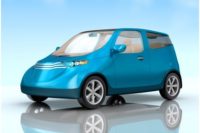Electric vehicles are most commonly advertised as passenger vehicles, designed to help the average commuter reduce their carbon footprint and pay less at the pump. Despite this stereotype, EVs are making their way into the commercial sector in the form of heavy equipment electric vehicles. How are electric vehicles (EVs) changing material handling?
The end of the internal combustion engine
Internal combustion engines (ICE) have been industry standards for commercial and consumer vehicles for over a century. The technology has evolved in the intervening years, but it has always relied on gasoline or diesel to keep those wheels turning.
As the world tries to prevent a climate crisis and moves away from relying on fossil fuels, many countries are planning to completely ban ICE-powered vehicles and equipment.
Norway and South Korea will have bans in place that go into effect in 2025. Belgium will follow in 2026 and Austria in 2027. By 2030, eight countries and one state – Washington – will ban ICE vehicles. Other countries and states will follow suit in the coming years.
Ultimately, the global population needs to reduce their carbon emissions by 40% before 2030 and reach net-zero emissions by 2050 if they hope to prevent the looming climate crisis.
Pros and cons of EVs in material handling
Electric vehicles are poised to become the best replacement for ICE-powered equipment, but they aren’t the perfect solution. What are some pros and cons of using commercial heavy equipment electric vehicles in industries like material handling?
Pro: No emissions
Reducing or eliminating CO2 emissions is the most commonly cited reason for switching from ICE to EV. Diesel or gasoline-powered cars can’t operate indoors safely without that ventilation.
Con: High initial ticket price
While the cost of EVs is slowly dropping, they still represent the most expensive equipment choice, at least for the initial purchase cost.
Pro: Lower Total Cost of Ownership (TCO)
Beyond the initial investment, the total cost of ownership (TCO) for an electric vehicle can be up to 30% less than their combustion-powered counterparts. EVs don’t require fuel and need less maintenance than the traditional internal combustion engine.
Con: Slow charging
What do your hours of operation look like? If an EV needs to be functional 24 hours a day – and shutting it down for 8-plus hours to charge isn’t an option – then you’ll need to look into alternatives.
Some EV equipment has the option for swappable battery packs, so you can have one pack on a charger while the other is in operation.
Pro: Quiet operation
There may be no way to eliminate all noise hazards in a material handling setting, but switching to EVs can help reduce them. The electric motors powering heavy equipment electric vehicles operate with a fraction of the noise generated by a gas or diesel engine.
Con: Specialized maintenance
EVs require less overall maintenance, but if something does break down, it’s often costly and requires the talents of an electrical engineer or specially trained technician. Keeping a mechanic on staff for traditional hardware might be cost-effective – the same statement can’t be said about EV technicians.
Pro: Maneuverability
The battery packs and motors that power an EV don’t take up as much space as traditional combustion engines. They also don’t require additional components like an intake or exhaust system.
Con: Battery drain
Have you ever had a battery-powered device that started losing its effectiveness as the battery drained? The same thing can happen to EVs as they discharge their batteries. A forklift, for example, might not be able to generate the same amount of torque at the end of a shift as it could at the beginning.
Improving material handling safety
In addition to the pros and cons listed above, incorporating electric vehicles into the material handling industry can help improve workplace safety.
The smaller size of electrical forklifts and other equipment in material handling settings means better maneuverability. It’s easier to fit this equipment into small or narrow spaces, which reduces the need to manually carry materials from one place to another. This maneuverability, in turn, can help reduce lifting-related injuries.
The lack of emissions in enclosed spaces makes it easier to prevent respiratory hazards like carbon monoxide poisoning. The vehicles also reduce or eliminate the need for additional ventilation in warehouses or other enclosed environments.
EVs are also far quieter than forklifts or other equipment powered by diesel or propane. Switching to EVs, especially in warehouses or other already-noisy facilities, can reduce noise pollution and prevent noise-related injuries.
Changing material handling for the better
With the pros and cons of EVs understood, how is this technology working to change material handling for the better?
Reduced carbon footprint
Sustainability is becoming a critical talking point for every industry. In addition to complying with the ICE bans that will start appearing around the world in the next decade, switching to EVs for material handling applications helps reduce the company’s overall carbon footprint.
It doesn’t offset carbon emissions entirely, at least not while major power grids still rely on fossil fuels, but it does remove one emissions source from the equation.
Adopting IoT
Combustion-powered material handlers are complex machines, but they are relatively rudimentary compared to modern EVs. Integrating technology into this equipment category creates the perfect opportunity to begin adopting the Internet of Things (IoT) to improve efficiency and productivity. IoT has applications like workplace safety, quality control, and providing real-time monitoring data.
Pairing this information with a machine learning or AI system allows operators to put this data to use, creating actionable insights and even predicting future events based on things that have happened in the past.
Lower overall costs
Once you’ve moved past the often high initial investment, the cost of maintaining an EV or even a fleet of EVs is much lower than their combustion-powered counterparts. There are no fuel costs to consider because the cost of powering an EV gets lumped in with the rest of your utility bills. Fewer moving parts mean there is little to no maintenance to consider.
Overall, the costs are lower and it’s easier to see a quick return on investment.
Instant torque
When hauling cargo or towing trailers, torque is critical. With gasoline or diesel power, the engine must reach a certain number of RPMs to deliver that torque. With EVs, there’s no need for that rev up – the torque is available instantly. Instant torque improves workplace efficiency and reduces fuel waste.
Looking forward
Electric vehicles are starting to make their mark in both commercial and consumer circles. In the material handling industry, switching to EVs could help lay the groundwork for making the industry more sustainable in the long run. Eventually, companies won’t be able to choose between electric or combustion power. With so many countries looking at banning gasoline and diesel engines, the switch to EVs will become mandatory sooner rather than later.




